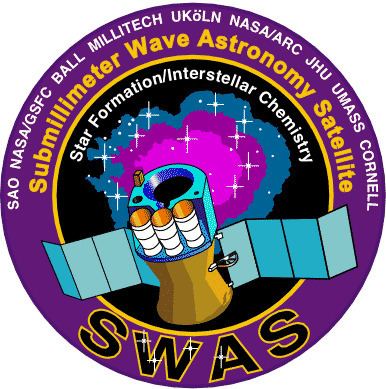Names Explorer-74, SMEX-3 COSPAR ID 1998-071A Launch date 5 December 1998 Inclination 69.8979° Rocket Pegasus | SATCAT no. 25560 Inclination 69.8979° Period 1.6 hours Launch site Vandenberg Air Force Base | |
 | ||
Mission type Submillimeter astronomy Similar High Energy Transient, CHIPSat, Wide Field Infrared Explorer, Solar Anomalous and Mag, TRACE | ||
The Submillimeter Wave Astronomy Satellite (SWAS) is a NASA submillimeter astronomy satellite, and is the third spacecraft in the Small Explorer program. It was launched on December 6, 1998 (UTC), from Vandenberg Air Force Base aboard a Pegasus XL rocket. The telescope was designed by the Smithsonian Astrophysical Observatory and integrated by Ball Aerospace, while the spacecraft was built by NASA's Goddard Space Flight Center. The mission's principal investigator is Gary J. Melnick.
Contents
Mission
SWAS was designed to study the composition and structure of interstellar clouds and investigate the processes of stellar and planetary formation. Its sole instrument is a telescope operating in the submillimeter wavelengths of far infrared and microwave radiation. The telescope is composed of three main components: a 55 × 71 cm (22 × 28 in) elliptical off-axis Cassegrain reflector, two Schottky diode receivers, and an acousto-optical spectrometer. The system is sensitive to frequencies between 487–557 GHz (538–616 μm), which allows it to focus on the spectral lines of molecular oxygen (O2) at 487.249 GHz; neutral carbon (C i) at 492.161 GHz; isotopic water (H218O) at 548.676 GHz; isotopic carbon monoxide (13CO) at 550.927 GHz; and water (H2O) at 556.936 GHz.
History
The Submillimeter Wave Astronomy Satellite mission was approved on April 1, 1989. The project began with the Mission Definition Phase, officially starting on September 29, 1989, and running through January 31, 1992. During this time, the mission underwent a conceptual design review on June 8, 1990, and a demonstration of the Schottky receivers and acousto-optical spectrometer concept was performed on November 8, 1991.
The mission's Development Phase ran from February 1992, through May 1996. The Submillimeter Wave Telescope underwent a preliminary design review on May 13, 1992, and a critical design review on February 23, 1993. Ball Aerospace was responsible for the construction of and integration of components into the telescope. The University of Cologne delivered the acousto-optical spectrometer to Ball for integration into the telescope on December 2, 1993, while Millitech Corporation delivered the Schottky receivers to Ball on June 20, 1994. Ball delivered the finished telescope to Goddard Space Flight Center on December 20, 1994. Goddard, which was responsible for construction of the spacecraft bus, conducted integration of spacecraft and instrument from January through March 1995. Spacecraft qualification and testing took place between April 1, 1995, and December 15, 1995. After this, SWAS was placed into storage until September 1, 1998, when launch preparation was begun.
The spacecraft was delivered to Orbital Sciences Corporation at Vandenberg Air Force Base on November 2, 1998, for integration onto their Pegasus XL rocket. Launch occurred on December 6, 1998, at 00:57 UTC, from Orbital Sciences' Stargazer L-1011 TriStar mothership. Its initial orbit was a near-circular 638 × 651 km (396 × 405 mi) with an inclination of 69.9 degrees.
SWAS was originally scheduled to launch in June 1995, but was delayed due to back-to-back launch failures of the Pegasus XL rocket in June 1994 and June 1995. A launch opportunity in January 1997 was again canceled due to a Pegasus XL launch failure in November 1996.
The commissioning phase of the mission lasted until December 19, 1998, when the telescope began producing useful science data. The SWAS mission had a planned duration of two years and a cost estimate of US$60 million, but mission extensions allowed for five and a half years of continuous science operations. During this time, data was taken on more than 200 astronomical objects. The decision was made to end science and spacecraft operations on July 21, 2004, at which time the spacecraft was placed into hibernation.
To support the Deep Impact mission at comet 9P/Tempel, SWAS was brought out of hibernation on June 1, 2005. Vehicle check-out was completed on June 5 with no discernible degradation of equipment found. SWAS observations of the comet focused on isotopic water output both before and after the Deep Impact impactor struck the comet's nucleus on July 4. While water output was found to naturally vary by more than a factor of three during the observation campaign, SWAS data showed that there was no excessive release of water due to the impact event. After three months of observation, SWAS was once again placed into hibernation on September 1, 2005.
As of 2015, SWAS remains in Earth orbit on stand-by.
